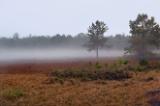 © Steve Vaughn/Panoramic Images (Florida Title Image Large)
© Steve Vaughn/Panoramic Images (Florida Title Image Large)

Conservation Overview
Florida is deservedly well known for its stunning white sand beaches, timeless cypress swamps alive with alligators and extravagantly plumed wading birds, and the Everglades, the nation’s only “river of grass.” But for those who look beyond these iconic images, a closer look reveals that the state’s natural wonders also encompass an astonishing diversity of species and ecosystems.
Florida is home to 45 terrestrial ecosystems that range from small islands of subtropical hammocks and rocklands to vast dry prairies, sandhills, scrubs, flatwoods and floodplain forests. And despite having little change in elevation, the difference of a few feet on the Florida peninsula can yield major landscape variations. Within flatwoods, for example, nearly imperceptible drops in elevation create a mosaic of depression marshes, dome swamps, and wet prairies. The topography changes more dramatically in the Panhandle where high bluffs and steep ravine systems flank the Apalachicola River and its tributaries.
The state’s 1,200 miles of coastline and thousands of inland freshwater lakes, rivers, streams and springs support numerous aquatic communities in its estuaries, seagrass beds, mangrove swamps, and coral reefs. Florida is home to more than 300 large artesian springs, and Wakulla Springs near Tallahassee is one of the largest in the world in terms of flow, as its crystal clear water rises up from an underground river at a rate of over 400,000 gallons per minute.
Florida’s peninsular geography spans temperate and subtropical zones, which, combined with its distinctive geology and climate, contribute not only to habitat diversity but also to an amazing array of species: about 700 vertebrates, more than 30,000 invertebrates and more than 4,000 native plant species. Florida hosts the greatest diversity of plant families of all U.S. states, and as many as 300 plants, 40 vertebrates and 400 invertebrates are found nowhere else in the world. These endemic species include the Florida scrub-jay, Key deer and Okaloosa darter, to name just a few. The ancient dune system of the Lake Wales Ridge in the central peninsula supports numerous endemics including the federally listed sand skink and Florida blazing star. Another center of endemism, the Miami Ridge rocklands of South Florida, contains numerous plant species unique to that region, most of which are federally endangered such as the rocklands morning glory and Florida brickell-bush
The Florida Panhandle is identified in Precious Heritage as a “biological jewel”, one of six nationwide biodiversity hotspots recognized for its combination of species rarity and richness. This region contains a remarkable variety of habitats, including hardwood forests, seepage slopes, pitcher plant bogs, caves, coastal sand dunes, and sandhills. Ancient relicts such as the Florida yew and Florida torreya persist within the steep ravine systems of this area.
Intact large-scale assemblages of species and natural communities can still be found in Florida thanks to numerous large protected areas that anchor nearly 10 million acres of conservation lands managed by federal, state, local and private agencies. Kissimmee Prairie Preserve State Park, covering 53,000 acres, protects the state’s largest remaining expanse of dry prairie, critical habitat for the Florida grasshopper sparrow. The Apalachicola National Forest encompasses over half a million acres and supports the largest remaining population of red-cockaded woodpeckers in the world. The 62,000-acre Three Lakes Wildlife Management Area contains prime examples of 19 different natural communities and sits in the midst of the highest concentration of bald eagle nests in the lower 48 states. The stealthy visitor may also encounter white-tailed deer, turkeys, Florida sandhill cranes, crested caracaras and burrowing owls.
Florida’s conservation lands not only protect the state’s biodiversity but also provide its residents with vital ecosystem services. Coastal buffer lands protect near-shore nursery habitats critical to commercial fisheries and provide a natural barrier to hurricanes. The wetlands that adjoin freshwater rivers, lands, streams, and springs serve as pollution filters, helping preserve the water quality within these systems. Natural uplands serve as recharge areas to the Floridan aquifer, our primary source of fresh drinking water. Florida’s 15 million acres of forests contribute to clean air and, along with the Everglades, play a significant role in national carbon sequestration.
More About Conservation in Florida
-
Partnerships
For those who look beyond the iconic images of Florida's beaches, cypress swamps, and the Everglades, the state's natural wonders encompass an astonishing diversity of species and ecosystems -- as well as a formidable array of individuals and organizations committed to conserving them for future generations.
-
Challenges
For those who look beyond the iconic images of Florida's beaches, cypress swamps, and the Everglades, the state's natural wonders encompass an astonishing diversity of species and ecosystems -- as well as a formidable array of individuals and organizations committed to conserving them for future generations.








